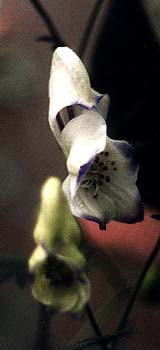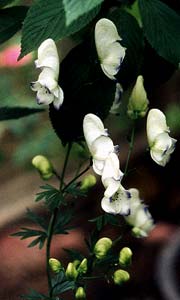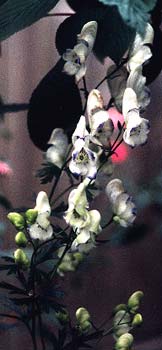
'Eleanor' Bicolor Monkshood:
A Lethal Witchcraft Perennial
"Flowers nodding gaily, scent in air,
Flowers posied, flowers for the hair,
Sleepy flowers, flowers bold to stare -
O pick me some!"
-T. Sturge Moore
(1870-1944)
(1870-1944)
We have two hybrid cultivars of monkshood which are Bicolor Monkshoods (Aconitum x cammarum 'Eleanor' is a Bicolor Monkshood, having spikes of white flowers, each flower's hood outlined in delicate blue-violet.
Eleanor's Monkshood grows three to four feet tall. Ours is sheltered by a large Dawn Viburnum & by surrounding upright or bushy perennials. Hot summers can trouble this cultivar, but it is easy to protect, as it will flower very nicely even in a goodly portion of shade. In our garden it begins blooming in July (when the first close-up was shot) with additional buds opening all the way up to August (when the second & third photos were shot). It has never rebloomed for us, but has a longer than average bloom time because its flower-buds do not mature all at the same time.
 All monkshoods prefer a mixture of sun & shade, with moist rich soil. With most of ours, the tall flower stalks are sufficiently sturdy they rarely need staking, though they may lean a little. 'Eleanor's' basal leaves are floppy & even sometimes semi-creeping, but the flower spikes have never needed staking.
All monkshoods prefer a mixture of sun & shade, with moist rich soil. With most of ours, the tall flower stalks are sufficiently sturdy they rarely need staking, though they may lean a little. 'Eleanor's' basal leaves are floppy & even sometimes semi-creeping, but the flower spikes have never needed staking.Monkshoods look best in a woodland-garden setting showing their helmet flowers amidst shrubbery, but can also be used in mixed borders of tall perennials.
Monkshood's dark green shiny foliage resembles delphinium's deeply cut foliage. Besides the common gardened monkshoods from the mountains of Europes, there are species with more or less identical appearance native of North America (vis, A. delphinifolium & A. columbianum) & all across Asia & Asia minor (vis, A. kusnezoffi & A. carmichaeli), so that the genus circles the northern hemisphere.
Even though every part of monkshood is very poisonous, & most especially the tuberous root, with just a little care of handling they can be used as cut flowers in arrangements. The primary risk is to anyone who would eat any part of the plant & especially the root, but at a lower level of risk, bear in mind it is not necessary to have an open cut for the skin to absorb the toxin, so if the plant's juices are on your skin, wash immediately with soap & water & be awfully careful about rubbing your eyes.
 An injested lethal dose of three to six milligrams of acotine can be obtained in as little as two to four grams of the root or green seedpods where the poison is particularly concentrated, or five milliliters of monkshood tincture. Symptoms begin in five minutes to four hours, but usually within ten to twenty minutes, severely afflicting the digestive system, nervous system, & heart. After vomiting, sweating, frothing, blurred vision, with alternating cold & burning sensations & paralysis, death can occur in as little as ten minutes, or take as long as 24 hours.
An injested lethal dose of three to six milligrams of acotine can be obtained in as little as two to four grams of the root or green seedpods where the poison is particularly concentrated, or five milliliters of monkshood tincture. Symptoms begin in five minutes to four hours, but usually within ten to twenty minutes, severely afflicting the digestive system, nervous system, & heart. After vomiting, sweating, frothing, blurred vision, with alternating cold & burning sensations & paralysis, death can occur in as little as ten minutes, or take as long as 24 hours.Prognosis is poor, as there is no such thing as a reliable antidote. Specific cause of death will likely be heart & respiratory failure. With a non-lethal dose, severe illness & motor impairment lasts 24 hours with other symptoms subsiding over a 40 hour period. If a victim recovers at all, there will be no long term after effects.
The poison survives cool dehydration & curing or tincture extraction. But it is largely deactivated by heating or cooking, otherwise there would be many more accidental deaths from it, for young plants have occasionally been mistaken for parsley, & the roots for horse radish or celery.
Monkshood or Wolfsbane has a long history of association with witchcraft. Having proved too dangerously toxic for the legitimate pharmacy, it fell to the province of sorcerers & witches. It was a believed by many Christians to be a common ingredient in witches' potions, as is the case in Nathaniel Hawthorn's great tale of "Young Goodman Brown." Monkshoods are occasionally named "Love Poison" because it was used in love potions, forever the most popular thing witches (or any crone with a lifetime of herblore in her) was asked to concoct. If the proportions were gotten wrong, or if it was over used when not effective on the first couple doses, the object of the potion's effect merely died.
Mixed with belladonna, it was thought to induce hallucinations, & a widespread but improbable story is that covens of witches rubbed a concoction of monkshood & belladona all over their bodies in order to fly, or at least imagine they were flying. The toxin can in fact be absorbed through skin, & can at least cause elevated sense of extreme well-being. So whether or not it was actually used within sorcerous covens, there seems little doubt that, given the nature of the human beast, it was often regarded worth the risk of death merely to get stoned.
Aconitum napellus, European Monkshood
for more legends of Monkshood & its deathly associations.